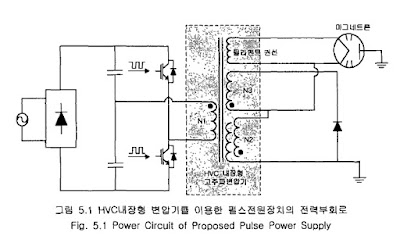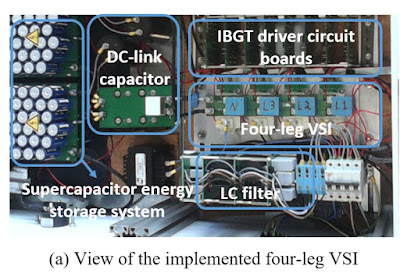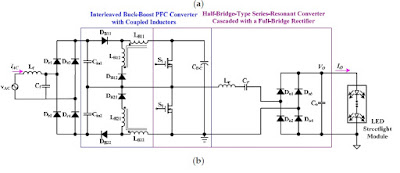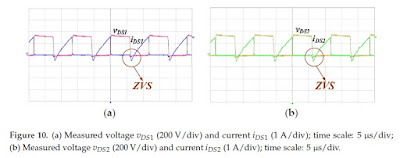segunda-feira, 24 de abril de 2017
A STUDY ON NOVEL PULSE POWER SUPPLY FOR MAGNETRON -KAN HEE PARK - MASTER PROGRAM IN ELECTRICAL ENGINEERING KONKUK UNIVERSITY
A STUDY ON NOVEL PULSE POWER SUPPLY FOR MAGNETRON USING HVC EMBEDDED HIGH FREQUENCY TRANSFORMER BY KANG HE PARK MASTER PROGRAM IN ELECTRICAL ENGINEERING GRADUATE SCHOOL OF KONKUK UNIVERSITY
ABSTRACT
A conventional power supply for driving magnetron has a ferro-resonant transformer ,a high voltage capacitor (HVC) and a high voltage diode.And it provides magnetron with 4000 volts DC ,which is produced by step-up transformer and doubler action of the diode and capacitor.
Though this power supply is simple,transformer is bulky,heavy and has low-fficiency.To improve hese defects a high frquency inverter type power supply has been investigated and developed in recent years.
However .because of additional control circuit and switching devices,inverter type power supply is more expensive than conventional one.Therefore.it is necessary to reduce production cost by all means.
This paper describes a novel HVC embedded high frequency transformer ,which embedding high voltage capacitor in its secondary winding.
LINK
http://www.mediafire.com/file/czruhtxse6a1r0m/STUDY_NOVEL_PULSE_POWER_SUPPLY_FOR_MAGNETRON.pdf
sexta-feira, 14 de abril de 2017
Design, Development and Control of >13 kV Silicon-Carbide MOSFET based Solid State Transformer (SST) by Gangyao Wang- North Carolina State University
Design, Development and Control of >13 kV Silicon-Carbide MOSFET based Solid State Transformer (SST) by Gangyao Wang
A dissertation submitted to the Graduate Faculty of North Carolina State University in partial fulfillment of the requirements for the Degree of Doctor of Philosophy
Electrical Engineering Raleigh, North Carolina
WANG, GANGYAO. Design, Development and Control of >13 kV Silicon-Carbide MOSFET based Solid State Transformer (SST).
ABSTRACT
Within the advent of the smart grid system, the solid state transformer (SST) will replace the traditional 60 Hz transformer formed by silicon steel core and copper windings and provides the interface between the high distribution voltage and low utility voltage. Other than the smaller size and less weight, SST also brings many more functionalities including voltage regulation, reactive power compensation, power management and renewable energy integration. The motivation of this research is to design a solid state transformer based on the wide band-gap Silicon Carbide (SiC) power MOSFETs and compare it with the silicon IGBT based SST. With wider band-gap and higher critical electrical field, the high voltage SiC power device has advantages over silicon power device for both conduction and switching. An extensive study and characterization of the SiC MOSFET was first carried out. It has been found that the MOSFET parasitic capacitors store significant amount of energy and the MOSFET turn on loss is high but turn off loss is virtually zero with small enough turn on gate resistor. A method for estimating the MOSFET parasitic capacitances has been proposed and explained in detail. A PLECS loss simulation model has been developed for the >13 kV SiC MOSFET which has been verified through a boost converter with the SiC MOSFET switches under 40 kHz for both soft switching and hard switching conditions separately. Widely used full bridge circuit has been chosen as the topology for the SST rectifier for its simple structure and bidirectional power transfer capability. Form three different SPWM modulation methods, the bipolar single frequency SPWM method has been identified as the most suitable control algorithm for the >13 kV SiC MOSFET base rectifier. With such modulation method, the generated PWM voltage frequency equals to the switching frequency, the each MOSFET equivalent switching frequency under hard switching conditions is only 1/4 of the PWM voltage frequency. The SST rectifier efficiency has been simulated and measured for 6 kHz and 12 kHz switching frequency with 6 kV dc bus voltage and 3.6 kV ac voltage, which is 99.2% for 6 kHz with 8.8 kW load and 98.5% for 12 kHz with 8.3 kW load.
The SST DC-DC stage utilize the dual active half bridge (DHB) as the topology, its zero voltage switching (ZVS) turn on range has been analyzed and it is concluded that the dead-time and device parasitic capacitances will reduce the ZVS range while the magnetizing current will increase the ZVS range. Since the SiC MOSFET has very high turn on loss, it is desired to have ZVS for the full load range. The high frequency transformer with integrated leakage inductance for the DHB operation has been designed, the magnetizing inductance has been decreased for increasing the ZVS range. The DC-DC stage efficiency has been measured as 96.9% for 10 kHz switching frequency and 10 kW load, and the peak efficiency is 97.5% for 10 kHz switching frequency and 5 kW load.
LINK VIEW FULL TEXT
https://repository.lib.ncsu.edu/handle/1840.16/9163
URL DIRECT :
https://repository.lib.ncsu.edu/bitstream/handle/1840.16/9163/etd.pdf?sequence=2&isAllowed=y
ALTERNATIVE LINK
http://www.mediafire.com/file/1eno463fcg4kj26/Design%2C_Development_and_Control_of_13_kV_SiliconC.pdf
AC-AC VOLTAGE REGULATION BY SWITCH MODE PWM CÛK VOLTAGE CONTROLLER WITH IMPROVED PERFORMANCE by Palash Kumar Banerjee - Ryerson University- Master of Engineering
AC-AC VOLTAGE REGULATION BY SWITCH MODE PWM CÛK VOLTAGE CONTROLLER WITH IMPROVED PERFORMANCE by Palash Kumar Banerjee
A project presented to Ryerson University in partial fulfillment of the requirement for the degree of Master of Engineering in the program of Electrical and Computer Engineering Toronto, Ontario, Canada, 2014
ABSTRACT
Title: AC-AC Voltage Regulation by Switch Mode PWM Cûk Voltage Controller With Improved Performance
Degree: Master of Engineering
Year: 2014
Student Name: Palash Kumar Banerjee
Program: Electrical and Computer Engineering University: Ryerson University, Canada
In this research project, an AC Cûk voltage regulator has been proposed for maintaining constant voltage across the load during wide range of input voltage fluctuations. The proposed AC Cûk voltage regulator made of practical IGBT switches has been investigated for both manual and automatic control circuit. A fraction of the output voltage is taken as the input voltage of the control circuit and produce the error signal if any changes occur in the output voltage. The modified error signal is used to make PWM signals for switching devices as per output voltage of regulator. The PWM controls the ON/OFF time (Duty cycle) of switching devices (IGBTs) of the proposed regulator. As a result the regulator is maintaining a constant voltage across the load during any change in supply voltage. The simulation waveforms and the calculated total harmonics distortion (THD) values are compared with previously studied AC Buck-Boost regulator. The observed simulated waveforms of output voltage, output current and input current and THD values have been improved in case of proposed AC Cûk voltage regulator.
LINK VIEW FULL TEXT
http://digital.library.ryerson.ca/islandora/object/RULA:2617
quarta-feira, 12 de abril de 2017
INFINEON HIGH POWER SEMINARIO TECNICO -TCT-ARTIMAR-27 ABRIL 2017 SÃO PAULO BRASIL
A TCT Brasil em parceria com a Artimar, está promovendo o primeiro seminário técnico da Infineon no Brasil sobre semicondutores de potencia. A líder mundial e seus especialistas prepararam uma agenda completa com os principais temas da atualidade, sobre módulos IGBTs e bipolares. Para credenciamento favor enviar e-mail - contato@tctbrasil.com.br
segunda-feira, 10 de abril de 2017
Output Voltage Quality Evaluation of Stand-alone Four-Leg Inverters Using Linear and Non-Linear Controllers- Instituto Superior de Engenharia de Lisboa
Output Voltage Quality Evaluation of Stand-alone Four-Leg Inverters Using Linear and Non-Linear Controllers Ricardo Luís , José Fernando Silva and José Carlos Quadrado
Instituto Superior de Engenharia de Lisboa, Polytechnic Institute of Lisbon,
Abstract:
This paper presents the design and experimental voltage quality evaluation of controllers for the output voltages of 3-phase four-leg voltage source inverters. These inverters are needed in stand-alone power systems to supply linear and non-linear, balanced or unbalanced loads with constant RMS value voltages at fixed frequency. Comparisons include closed loop outer voltage controllers based on predictive, sliding mode and decoupled proportional-integral controllers in dqo synchronous space, fitted with an inner hysteretic current loop vector controller in abg space. The 3-phase four-leg VSI output voltages waveform quality is analysed under unbalanced and non-linear loads. Received: 7 February 2017; Accepted: 29 March 2017; Published: 9 April 2017
Download PDF [5971 KB, uploaded 9 April 2017]
http://www.mdpi.com/1996-1073/10/4/504/pdf
segunda-feira, 3 de abril de 2017
A High-Efficiency Isolated-Type Three-Port Bidirectional DC/DC Converter for Photovoltaic Systems Yu-En Wu and Pin-Nan Chiu Department of Electronic Engineering, National Kaohsiung First University of Science and Technology,Taiwan
A High-Efficiency Isolated-Type Three-Port Bidirectional DC/DC Converter for Photovoltaic Systems Yu-En Wu * and Pin-Nan Chiu Department of Electronic Engineering, National Kaohsiung First University of Science and Technology, Kaohsiung 824, Taiwan
Abstract
This paper proposes a novel high-efficiency isolated three-port bidirectional DC/DC device for photovoltaic (PV) systems. The device contains a high step-up converter for PV modules to supply power to the DC bus, and a bidirectional charge/discharge control circuit for the battery with an improved boost-flyback converter. When the PV modules supply sufficient energy, their output can be stepped up and energy supply to the DC bus and charging of the battery can be achieved simultaneously. However, when the energy supplied is insufficient, the battery provides energy to the DC bus. When the proposed converter is operated in the step-down mode, the DC-blocking capacitor on the high-voltage side is used to reduce the voltage on the transformer and achieve high step-down performance. Moreover, to improve the overall efficiency of the system, the energy stored in the leakage inductance is recycled and supplied to the DC-blocking capacitor during operation in the step-up mode. Finally, to verify the feasibility and practicability of the proposed devices, a 500 W three-port bidirectional DC/DC devices was implemented. The highest efficiencies achieved for operation in different modes were as follows: high step-up mode for the PV modules, 95.2%; battery step-up mode, 94.2%; and step-down mode, 97.6%. View Full-Text Keywords: isolated type; three-port bidirectional converter; photovoltaic systems.
LINK ORIGINAL
http://www.mdpi.com/1996-1073/10/4/434
sexta-feira, 31 de março de 2017
A PSR single-stage flyback LED driver with simple line regulation and quasi-resonant operation Nie Weidong(聂卫东) 1; 2; Ž, Yu Zongguang(于宗光) 1 , Wang Haibing(王海兵) 2 , Guo Bin(郭斌) 2 , Teng Long(滕龙) 2 , and Yang Lihang(杨力航) -Department of Electronic Engineering, Jiangnan University China
Abstract:
A single-stage flyback driving integrated circuit (IC) for light-emitting diodes (LEDs) is proposed. With an average primary-side current estimation and negative feedback networks, the driver operates in the boundary conduction mode (BCM), while the output current can be derived and regulated precisely. By means of a simple external resistor divider, a compensation voltage is produced on the ISEN pin during the turn-on period of the primary MOSFET to improve the line regulation performance. On the other hand, since the delay time between the time that the secondary diode current reaches zero and the turn-on time of the MOSFET can be automatically adjusted, the MOSFET can always turn on at the valley voltage even if the inductance of the primary winding varies with the output power, resulting in quasi-resonant switching for different primary inductances. The driving IC is fabricated in a Dongbu HiTek’s 0.35 m bipolar-CMOS-DMOS process. An 18 W LED driver is finally built and tested. Results show that the driver has an average efficiency larger than 86%, a power factor larger than 0.97, and works under the universal input voltage (85–265 V) with the LED current variation within 0.5%.
VIEW FULL TEXT
http://www.jos.ac.cn/bdtxben/ch/reader/create_pdf.aspx?file_no=13122603
LINK ALTERNATIVO
http://www.mediafire.com/file/85fyffk0jdxtehq/A_PSR_single-stage_flyback_LED_driver_with_simple_line_regulation.pdf
A Single-Stage High-Power-Factor Light-Emitting Diode (LED) Driver with Coupled Inductors for Streetlight Applications - Chun-An Cheng, Chien-Hsuan Chang, Hung-Liang Cheng , Ching-Hsien Tseng and Tsung-Yuan Chung-Department of Electrical Engineering, I-Shou University,TAIWAN
A Single-Stage High-Power-Factor Light-Emitting Diode (LED) Driver with Coupled Inductors for Streetlight Applications Chun-An Cheng, Chien-Hsuan Chang, Hung-Liang Cheng *, Ching-Hsien Tseng and Tsung-Yuan Chung Department of Electrical Engineering, I-Shou University, Dashu District, Kaohsiung City 84001, Taiwan;
Abstract:
This paper presents and implements a single-stage high-power-factor light-emitting diode (LED) driver with coupled inductors, suitable for streetlight applications. The presented LED driver integrates an interleaved buck-boost power factor correction (PFC) converter with coupled inductors and a half-bridge-type series-resonant converter cascaded with a full-bridge rectifier into a single-stage power conversion circuit. Coupled inductors inside the interleaved buck-boost PFC converter sub-circuit are designed to operate in discontinuous conduction mode (DCM) for achieving input-current shaping, and the half-bridge-type series resonant converter cascaded with a full-bridge rectifier is designed for obtaining zero-voltage switching (ZVS) on two power switches to reduce their switching losses. Analysis of operational modes and design equations for the presented LED driver are described and included. In addition, the presented driver features a high power factor, low total harmonic distortion (THD) of input current, and soft switching. Finally, a prototype driver is developed and implemented to supply a 165-W-rated LED streetlight module with utility-line input voltages ranging from 210 to 230 V.
View Full-Text :
http://www.mdpi.com/2076-3417/7/2/167/pdf
A Single-Stage LED Tube Lamp Driver with Power-Factor Corrections and Soft Switching for Energy-Saving Indoor Lighting Applications Chun-An Cheng Department of Electrical Engineering Taiwan
Abstract:
This paper presents a single-stage alternating current (AC)/direct current (DC) light-emitting diode (LED) tube lamp driver for energy-saving indoor lighting applications; this driver features power-factor corrections and soft switching, and also integrates a dual buck-boost converter with coupled inductors and a half-bridge series resonant converter cascaded with a bridge rectifier into a single-stage power-conversion topology. The features of the presented driver are high efficiency (>91%), satisfying power factor (PF > 0.96), low input-current total-harmonic distortion (THD < 10%), low output voltage ripple factor (switching (ZVS) obtained on both power switches. Operational principles are described in detail, and experimental results obtained from an 18W-rated LED tube lamp for T8/T10 fluorescent lamp replacements with input utility-line voltages ranging from 100 V to 120 V have demonstrated the functionality of the presented driver suitable for indoor lighting applications.
LINK ORIGINAL View Full-Text
http://www.mdpi.com/2076-3417/7/2/115/pdf
Assinar:
Postagens (Atom)



































































 JOSIL ARTISTA PLASTICO FORTALEZA CEARA BRASIL AV.HERACLITO GRAÇA 41 TEL(85)32542378
JOSIL ARTISTA PLASTICO FORTALEZA CEARA BRASIL AV.HERACLITO GRAÇA 41 TEL(85)32542378















